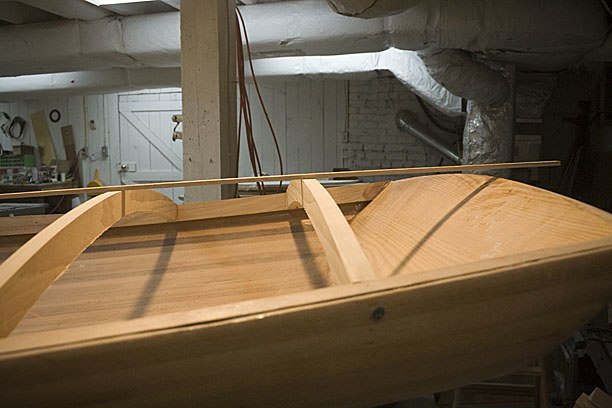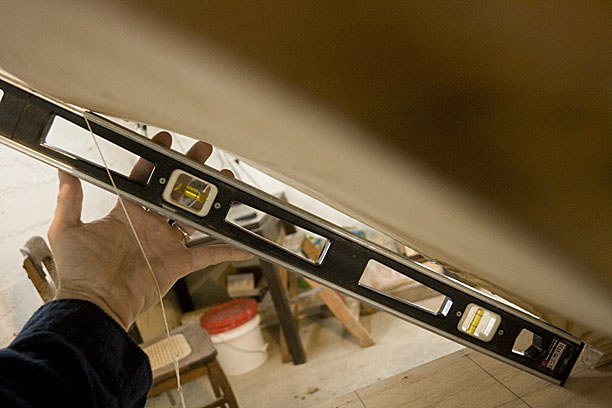About those towels . . .
Here’s one of those little problems that you don’t really factor into work the schedule. It’s not covered in the manual, but it’s one of the major hazards of any woodworking project that spans several seasons. See, wood, as an organic material, has evolved structurally over millions of years to be very good at absorbing water at one end of the tree and transporting it to another. Every fiber, every cell, is designed for this. Just because you cut the tree down doesn’t stop that structure from working entirely. Imagine that! It still works like a sponge, and so shrinks and swells as it absorbs and releases moisture. But it does it so slowly, and our projects are usually completed so quickly, that we don’t notice it. Not so with a boat project that has already seen the passing of four full seasons.
As I was laying out the deck beams, all carefully sized and aligned, I noticed that a strip laid across them no longer lined up with the top of the transom. Not a little. It was off by a half inch. Dang it!
Misalignment of deck to transom.
I checked and rechecked all the measurements, and they all checked out. Hmmm. Scratching of head repeatedly did not help. Checked again. Went to bed. Then checked again the next morning. Everything was still right, but the gap was still there.
Could I have got the transom wrong to begin with? No, because the deck strips were laid down and glassed with the transoms in place a few months ago, and it all lined up perfectly. Then, as I was looking at the unnerving gap, and thinking how I might now have to shim things to get it all to fit again, I noticed an odd curve in the transom itself, and it finally dawned on me. Suspicious, I checked the thermometer/hygrometer I keep in the shop – yup. A quick check of the dates on the project photos confirmed it. The wood had shrunk – a lot. How much? Well, hard to say, but the bigger problem is that it was only shrinking on one face, warping the transom. How much? Well, enough that when I laid a level against it there was almost a full inch gap at the peak of the curve. That curve is pulling the crown of the transoms down and away from the deck, ruining that classic gentle sheer line in the deck profile.
Warping of transom.
The interiors, including the insides of the transoms, were glassed at the end of July. The outsides were glassed the previous April, but I left the outsides of the transoms bare, because they’ll have a final outer layer of walnut epoxied to them when the boats are nearly done. That layer of glass and epoxy on the inside is keeping the inner surface stable and fixed, while the bare outer surface is shrinking and swelling with the ambient humidity. This difference is causing the wood to warp.
In July the humidity averaged between 70 and 80 percent. On this day in January we’re in the midst of an unusual weather pattern. Very unusual. There’s a kink in the Jet Stream over the Northern Hemisphere, and that kink has affected weather patterns in a weird backwards world sort of way. It’s been bitter cold here for almost a solid month. Records are falling all over the Southeast. This morning it was colder in Tampa, Florida, than in Anchorage, Alaska. It was colder under the palm trees in St. Augustine than in Greenland, home to second largest block of ice on face of the planet. The Gulf Stream, which usually flows toward northern Europe, keeping it temperate, has flipped back on itself and is flowing northward up the west coast of Greenland into the Arctic instead. As a result, not only is the Arctic unusually warm, but England is covered in snow for the first time in decades. Spring flowers are blooming on the ski slopes of Bulgaria, while parts of the UK set record lows of -6 degrees Fahrenheit (-21C). Weird.
 England without the Gulf Stream.
England without the Gulf Stream.
Cold weather here means low humidity – even in the basement it’s been averaging around 28%. It’s that difference between the humidity in July and January that’s messing everything up, certainly. To test the theory, I put a towel in a bucket of water for a wick and set the bucket on the strongback next to the transom of each boat, then wrapped the whole thing in plastic with the hygrometer inside.
Bucket of water with towel wick.
After two days the humidity had risen to 40%. I took out the level and made another measurement, and the 1 inch gap had been reduced to just over 1/4”. Great! Now I just have to raise the humidity in the whole basement. The only problem is that’s not working too well. It’s a big room. I’ve installed three homemade humidifiers – buckets full of water, with towel wicks and fans – and with them am pumping 5 gallons of water a day into the air in the room, but I still can’t get the humidity for the whole room above 30%.
At this point I’m not sure what to do. I’ve noticed the same warping of the transoms is also happening to the decks, which are also only glassed on one side. Back in July I had noticed a slight cupping in the keel planks when it came time to glass the insides, but thought it was due to the sides of the hulls falling open under their own weight. Now I know that the cupping is from glassing the outsides in April and the insides in July.
I either have to buy some commercial humidifiers or wait for warmer weather. Maybe in another week this cold snap will finally break. Then my wet towel buckets may be enough to do the trick. I think I’ll postpone doing anything for now, and wait and see.
In the meantime, I have a couple of posts in the works on related subjects I can work up while we wait.
melonseed skiff, mellonseed skiff, melon seed, mellon seed









Hey, I think your site might be having browser compatibility issues. When I look at your blog site in Ie, it looks fine but when opening in Internet Explorer, it has some overlapping. I just wanted to give you a quick heads up! Other then that, very good blog!